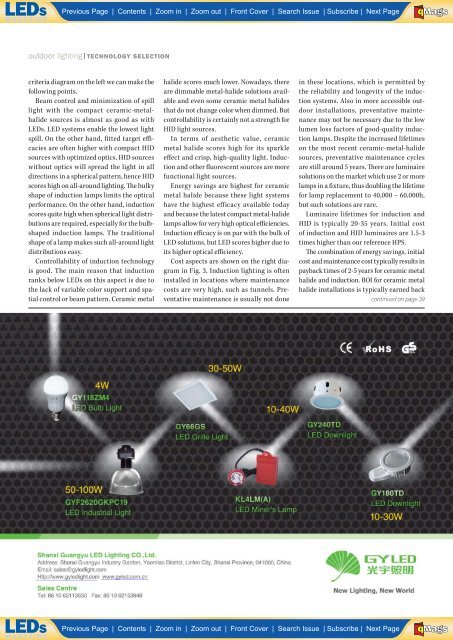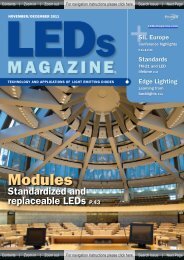The best solutions for any LED measurement application! - Beriled
The best solutions for any LED measurement application! - Beriled
The best solutions for any LED measurement application! - Beriled
Create successful ePaper yourself
Turn your PDF publications into a flip-book with our unique Google optimized e-Paper software.
A<br />
Previous Page | Contents | Zoom in | Zoom out | Front Cover | Search Issue | Subscribe | Next Page M S BE<br />
aG<br />
F<br />
outdoor lighting | TECHNOLOGY SELECTION<br />
criteria diagram on the left we can make the<br />
following points.<br />
Beam control and minimization of spill<br />
light with the compact ceramic-metalhalide<br />
sources is almost as good as with<br />
<strong>LED</strong>s. <strong>LED</strong> systems enable the lowest light<br />
spill. On the other hand, fi tted target effi -<br />
cacies are often higher with compact HID<br />
sources with optimized optics. HID sources<br />
without optics will spread the light in all<br />
directions in a spherical pattern, hence HID<br />
scores high on all-around lighting. Th e bulky<br />
shape of induction lamps limits the optical<br />
per<strong>for</strong>mance. On the other hand, induction<br />
scores quite high when spherical light distributions<br />
are required, especially <strong>for</strong> the bulbshaped<br />
induction lamps. <strong>The</strong> traditional<br />
shape of a lamp makes such all-around light<br />
distributions easy.<br />
Controllability of induction technology<br />
is good. <strong>The</strong> main reason that induction<br />
ranks below <strong>LED</strong>s on this aspect is due to<br />
the lack of variable color support and spatial<br />
control or beam pattern. Ceramic metal<br />
_____________ __________<br />
halide scores much lower. Nowadays, there<br />
are dimmable metal-halide <strong>solutions</strong> available<br />
and even some ceramic metal halides<br />
that do not change color when dimmed. But<br />
controllability is certainly not a strength <strong>for</strong><br />
HID light sources.<br />
In terms of aesthetic value, ceramic<br />
metal halide scores high <strong>for</strong> its sparkle<br />
eff ect and crisp, high-quality light. Induction<br />
and other fl uorescent sources are more<br />
functional light sources.<br />
Energy savings are highest <strong>for</strong> ceramic<br />
metal halide because these light systems<br />
have the highest efficacy available today<br />
and because the latest compact metal-halide<br />
lamps allow <strong>for</strong> very high optical effi ciencies.<br />
Induction effi cacy is on par with the bulk of<br />
<strong>LED</strong> <strong>solutions</strong>, but <strong>LED</strong> scores higher due to<br />
its higher optical effi ciency.<br />
Cost aspects are shown on the right diagram<br />
in Fig. 3. Induction lighting is often<br />
installed in locations where maintenance<br />
costs are very high, such as tunnels. Preventative<br />
maintenance is usually not done<br />
in these locations, which is permitted by<br />
the reliability and longevity of the induction<br />
systems. Also in more accessible outdoor<br />
installations, preventative maintenance<br />
may not be necessary due to the low<br />
lumen loss factors of good-quality induction<br />
lamps. Despite the increased lifetimes<br />
on the most recent ceramic-metal-halide<br />
sources, preventative maintenance cycles<br />
are still around 5 years. Th ere are luminaire<br />
<strong>solutions</strong> on the market which use 2 or more<br />
lamps in a fi xture, thus doubling the lifetime<br />
<strong>for</strong> lamp replacement to 40,000 – 60,000h,<br />
but such <strong>solutions</strong> are rare.<br />
Luminaire lifetimes <strong>for</strong> induction and<br />
HID is typically 20-35 years. Initial cost<br />
of induction and HID luminaires are 1.5-3<br />
times higher than our reference HPS.<br />
Th e combination of energy savings, initial<br />
cost and maintenance cost typically results in<br />
payback times of 2-5 years <strong>for</strong> ceramic metal<br />
halide and induction. ROI <strong>for</strong> ceramic metal<br />
halide installations is typically earned back<br />
continued on page 39<br />
A<br />
Previous Page | Contents | Zoom in | Zoom out | Front Cover | Search Issue | Subscribe | Next Page M S BE<br />
aG<br />
F

















